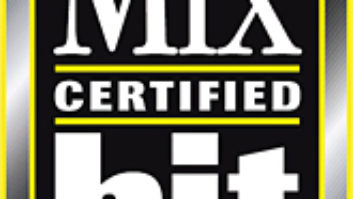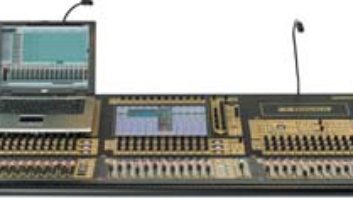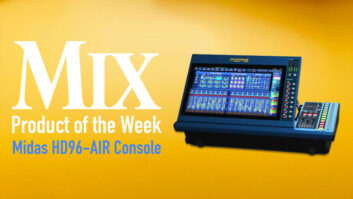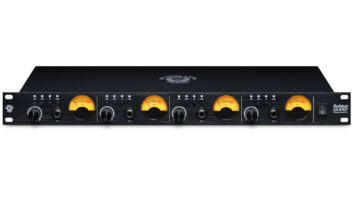Saying he’d “waited nearly 20 years” for the moment, Midas managing director, John Oakley, presented the first digital console to carry the Midas name, the XL8, during Frankfurt’s MusikMesse/Pro Light and Sound expo. The 3-year console development program received a green light and a $10 million funding pool in 2003. Midas marketing director, David Cooper, said the “XL8 meets Midas core values” of sonic integrity, ease of use and operator peace of mind.
The large-format console is extremely ambitious in scope, its capabilities as expansive as the reported price of over $300,000. The XL8 features multiple input boxes, with dual redundancy in connections (Cat-5 or optical), routers, output boxes and DSP/master controllers.
Brand development manager, Richard Ferriday, proclaimed the XL8 as more than just a console, calling it a “hardware distributed system.” Recognizing that in any complex system, “sooner or later, something is going to go wrong,” Ferriday said that managing potential failure was a big part of the design. To that end, the XL8 is touted as having no single point of failure that would bring the system down–faults can cause a loss of channels and features, but not total system failure. Outside of the hardware and software, creation of a support network was considered and an essential part of the console development. That network includes 24/7 support through global telephone access to one of four international call centers equipped with an XL8 and manned by trained technicians. Two-tiered training certification and three levels of support (from Midas, their distributors and XL8 users) are also part of the network.
Midas research and development director Simon Harrison says the MidasNET audio distribution network, though using the Ethernet physical layer (making it hardware compatible with IT industry standards) does not have the packet delays associated with Ethernet signal protocol-based approaches. There’s no waiting for packets of data before distribution; a MidasNET link (Cat-5 or optical) sends data as soon as it is available, and the links all run at 96 kHz to further reduce latencies. The two versions of the links are a local link with 24 bidirectional audio channels and a trunk route with up to 192 bidirectional channels. Harrison called the 70-microsecond latency per link “absolutely crucial” to the XL8 architecture. Six hops through MidasNET would only add up to .4 mS, with total system latency, including A/D and D/A conversion under 2 mS. Full clock distribution and management is distributed with the audio, and the whole network is claimed automatically in phase and sample synchronous, something Harrison said is “not true on any other digital console currently available.”
When spec’ing MidasNET, the design team forged one of two strategic alliances with outside manufacturers, discovering that the Sony Oxford group’s SuperMac and HyperMac protocols perfectly matched the design goals. Now codified in the AES50 standard, the technology offered the advantages of a proven interface with open architecture employing standard hardware. In the second strategic alliance, the XL8, built around a “stable” Linux platform and using proprietary Midas algorithms, incorporates a mature digital engine OEM’d from another manufacturer that Midas declined to name. The advantage in this case was that from “day one” of XL8 development, the design team was able to create simple versions of all modules and to integrate and test the entire system as they enhanced each module to full specification.
The attention to detail and application in the XL8 is apparent in the specification of the 24-channel DL431 stage box, which has 24 inputs, each channel split to two separate remote-controllable mic pre stages (so FOH and monitors could be controlled independently, for instance, with dual MidasNET outputs and control, as well as front-panel control and monitoring). A total of 24 transformer isolated front-panel unity gain analog outputs are additionally fed from the same inputs. The rest of the hardware complement is comprised of audio routers, configurable I/O boxes and the DSP engines. Though the base price includes a comprehensive array of interface and functionality, additional pieces can be added for a “huge” number of possible configurations.
The human interface of the XL8 is the Control Center that presents an expansive range of controls and visual feedback. Ferriday said the control paradigm is specifically designed for live use, is consistent with that of Midas analog consoles, and is “fundamentally different” than other digital consoles. The XL8 was developed by the core Midas console team, steeped in analog experience and led by director of console engineering, Alex Cooper. The XL8 concept is to have instantly recognizable features and functions, without resorting to the manual, using styling and color-coding to enhance the operator experience. To lessen the height of the deep control surface, daylight-visible display screens for each fader bay are sunk into a well, though keeping them visible to the operator. Any of the screen signals can be tapped for remote monitors, and the console screens can be used to display external video feeds.
The surface has three fader bays to control inputs with comprehensive displays showing channel function status, a “VCA” (Variable Control Association, in Midas parlance) bay for centralized mixing and aux master control (with an “all channels, all the time” input and output meter display screen) and an output control bay handling stereo and mono busses, and control of the 16 matrix masters. The channel strips are more populated with quasi-dedicated controls than most digital desks, giving immediate access at all times to input gain, a pair of aux sends (selectable), dynamics thresholds, input and dynamics metering and more. The 48 inputs are controlled by the 24 channel faders, layered recall and through “POP” population groups of user-assignable instrumentation groups (color-keyed) and VCA groups (also color-keyed). The XL8 has 32 configurable mix busses that can be sub-group, sub-mix or mix-minus feeds. Up to 48 simultaneous foldback mixes are possible.
When developing the digital algorithms for the mic pre performance, EQ and dynamics, extensive research was undertaken to model the unique analog characteristics and behavior of Midas mic pres and processing, and that of a host of popular dynamics and EQ processors from other manufacturers. The result is not a series of cloned processors, but a palette of available EQ and dynamics processors that emulate the desirable aspects of different approaches. In addition, the “feel” of the controls, say, when sweeping an EQ, produce the phase shifts and rapid interpolation needed to model analog behavior. Available “plug-ins” provide additional processing, also Midas developed with no third-party path envisioned for onboard processing.
With the XL8, Midas believes they have bridged the transition from analog to digital with as much familiarity as possible, in a comprehensively spec’d system.






